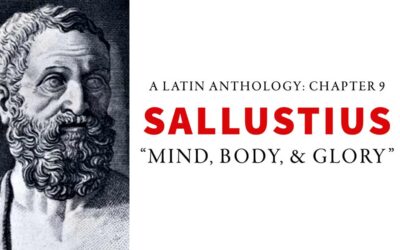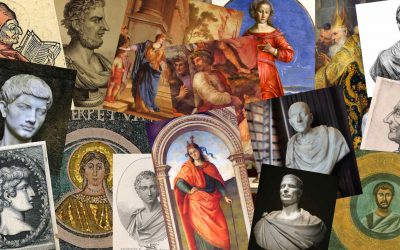Contents
The Hunt for Saxo
Shortly after the year 1208, Saxo Grammaticus put the finishing touches to his great history of Denmark, Gesta Danorum, ‘The Deeds of the Danes’. This work, written in a beautiful but idiosyncratic Latin, offers an abundance of stories about Danish kings and heroes and, intriguingly, translations into Latin of Old Norse poetry – the originals of which have almost all been lost.
Christiern Pedersen’s Search
By the early 16th century, however, manuscripts of this monumental work were hard to come by. The cleric and would-be-editor Christiern Pedersen put his frustration into words.
“Bibliothecas omnes visi et revolvi; nec tamen Saxonem blattis, tineis, situ et pulvere obsitum eruere potui. Tam obstinato animo eius possessores eum occluserant.”
‘I visited and returned to every single library, and still could not root out Saxo from the moths, worms, mold and dust. So stubbornly had the owners hidden him away.‘
At this time, Christiern Pedersen was studying in Paris and had befriended a few Parisian printers with the purpose of editing various Danish historical works. It was a Danish bishop, Lage Urne of Roskilde, Denmark, who exhorted him in 1512 to make a printed edition of Gesta Danorum. Saxo was well known, not least through an abbreviated and simplified version called Compendium Saxonis and as a source text for other medieval writings; Gesta Danorum itself, however, was less easy to find, and the owners of its surviving exemplars were unwilling to part from them. The bishop deplored the fact that the work had remained unavailable for so long (“multis … annis in obscuro delituisse dolemus”). Consequently, Christiern Pedersen sent two messengers to Denmark in order to procure a copy “at any price.” They did not succeed. He went back himself, but having searched through all the libraries of Denmark was almost ready to give up, when Archbishop Birger Gunnersen of Lund announced to him that he had found an exemplar, possibly dug up from the archdiocese library or found in a local monastery.
The First Printed Edition of Gesta Danorum
Christiern Pedersen made a triumphant return to Paris, where he set to work with the printer Jodocus Badius in making a first edition (editio princeps) of the Gesta. Jodocus Badius Ascensius (Josse van Asche) was a famous humanist who edited and published a number of classical works in his lifetime, including Latin translations of Hesiod’s Works and Days and of Plutarch, as well as several works by Erasmus. He himself wrote several commentaries: to Terence’s comedies and to Vergil, Horace, Juvenal and Persius.
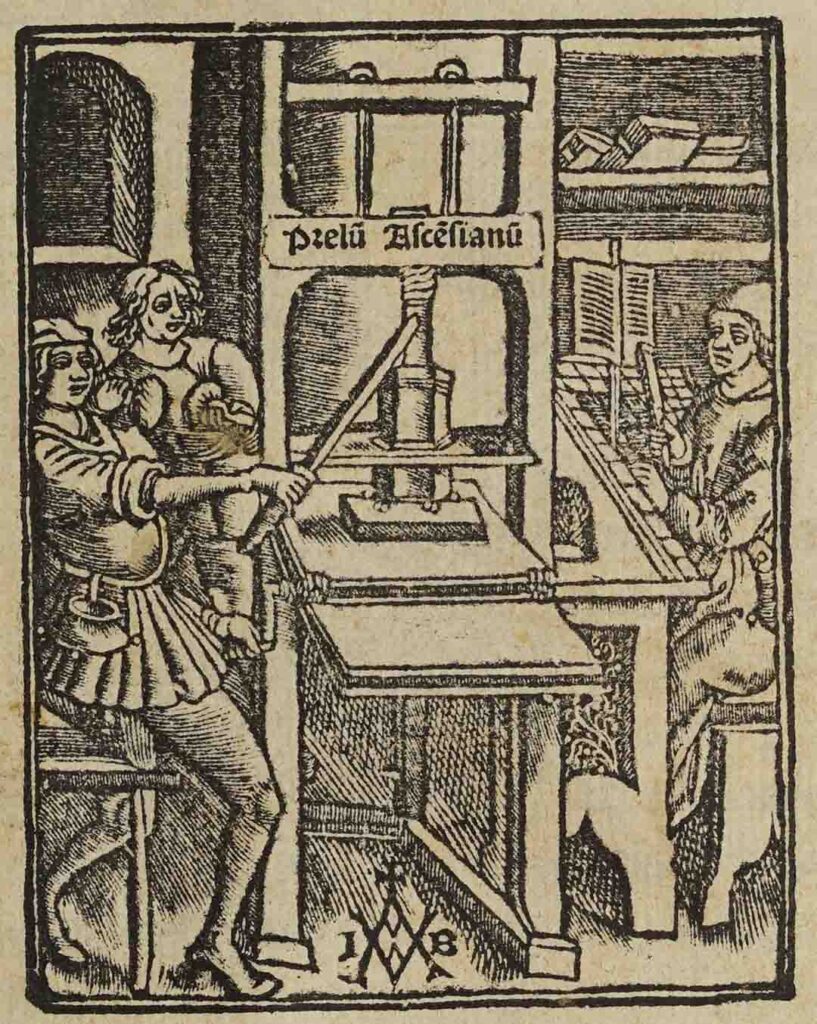
It was a substantial task to transcribe the manuscript and produce a correct and emended text. Finally, in 1514 the Ascensian press (Prelum Ascensianum) published the first edition of Gesta Danorum.
Gesta Danorum
Amleth, or Hamlet, That Is the Question.
To many people, Saxo’s history is best known for having an early version of the story of Hamlet (or Amleth). The recent movie The Northman by director Robert Eggers is said to be based on Saxo’s version – but having watched it, I see few similarities besides the names and the basic premise. This notwithstanding, the movie is excellent, brutal and has stunning cinematography, but I was surprised by how much its latter half resembled the Icelandic film When the Raven Flies (Hrafninn flýgur, 1984). Concerning Amleth, there is an allusion to this prince in an early Old Norse poem, which suggests that the material is much older than the extant Danish sources.
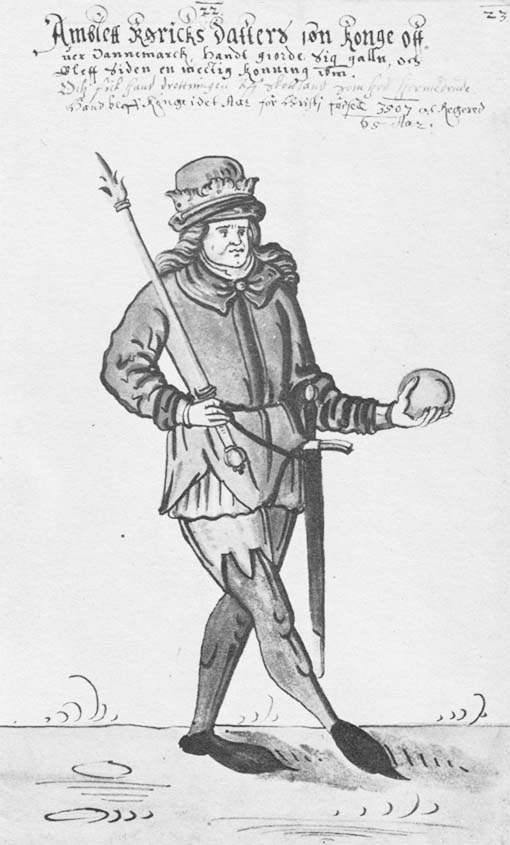
Norse Gods, or Men
Other famous stories, such as the legend of William Tell, have forerunners in Saxo’s work – though the hero in this case is named Toko (in Old Norse sources called Pálnatóki) and the king is Harald Bluetooth. Indeed, the first half of the history, concerning pagan times, is replete with giants, dragons and magicians – and myths of the Norse gods, who, in accordance with the so-called euhemeristic tradition, are portrayed as humans who have deceived the populus into believing them to be gods. The second half of the work is more concerned with historical Danish kings – from the conversion to Christianity up until Saxo’s own time.
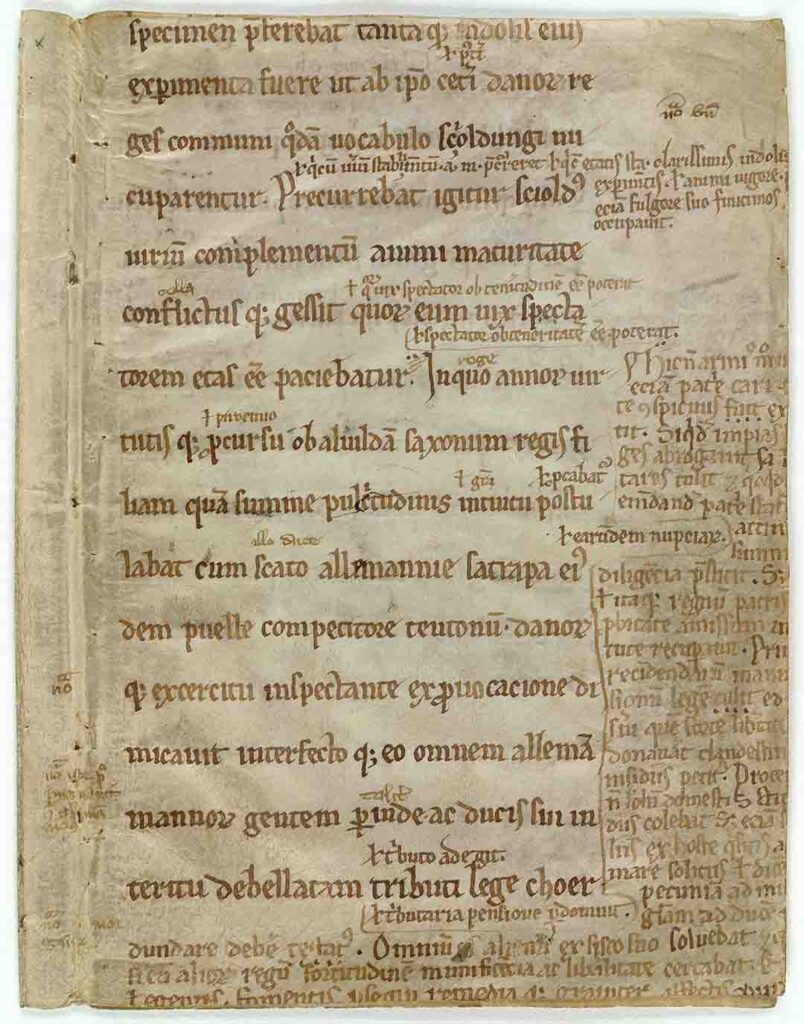
This is all related in a very distinctive Latin, which will be described below. First, however, let’s get one pertinent question out of the way, that of his name.
The Name “Saxo Grammaticus”
So what is the meaning of our beloved author’s name? Saxo, as you might have guessed, is indeed a cognate with the English seax (and likely with the ethnonym Saxon). Saxo is a Latinization of the Old Danish Saksi/Saxi, ‘sword’, which was not an uncommon name in those days; indeed, we know of several other Saxones from the same era.
Grammaticus denotes someone who knows letters, perhaps best translated as ‘scholar’ or ‘learned’ – during this era of course signifying a churchman with good knowledge of Latin. Saxo was described as such in recognition of his learning, and what started as a description, ended up as his cognomen. The publisher of the 1514 printed edition, Jodocus Badius, provides the following explanation:
“Enimvero, auctore Suetonio, grammaticus est qui diligenter, acute, scienterque norit aut dicere aut scribere. Quo nomine Cornelius Nepos appellandos censuit poetarum oratorumque interpretes, qui tantum auctoritatis apud priscos praeripuerunt, ut censores et judices essent scriptorum omnium soli.”
Jodocus Badius
‘Indeed, according to Suetonius, a grammaticus is one who knows how to either speak or write attentively, discerningly and intelligently. By this word Cornelius Nepos thought that interpreters of poets and speakers should be designated, those who had such authority among the ancients that they alone were seen as critics and judges of literature.’
Saxo the Latinist: A Classical Outlook
The printed edition of Saxo’s Gesta Danorum was to exert great influence on Nordic historiography, but it also gave rise to praise among humanist scholars for its language and style. Erasmus himself got hold of a copy and, in the dialogue Ciceronianus (1528), has one of the characters commend it in the following words:
“Probo vividum et ardens ingenium, orationem nusquam remissam aut dormitantem, tum miram verborum copiam, sententias crebras, et figurarum admirabilem varietatem; ut satis admirari non queam, unde illa aetate homini Dano tanta vis loquendi suppetierit, sed vix ulla in illo Ciceronis lineamenta reperias.”
Erasmus, Ciceronianus 1528: 174
‘I praise his lively and sharp intellect, the language, which is never weary or heavy with sleep, and moreover his rich vocabulary, many sayings and admirable variety of stylistic figures, to the extent that I cannot help but wonder, where a Dane of this age could acquire such power of expression; but one hardly finds any Ciceronian traits in him.’
It is no surprise that Erasmus found Saxo’s Latin so appealing. The language and style of Gesta Danorum is in fact remarkably classical – though being, as he states, far from Ciceronian.
Golden Age Latin Models
Certainly, Saxo’s poetic models are mainly Golden Age Latin. Vergil was his favourite, but he is also well-versed in the poetry of Horace, and draws inspiration at several points from lines by Juvenal and Ovid, as well as by later poets, such as Prudentius and Martianus Capella. The latter might also partly have influenced Saxo in making a few books of the history prosimetric – a mixture of prose and verse. The poems are all inserted as speeches or dialogue between the characters.
Saxo’s prose models are perhaps more surprising. Most of the parallels and allusions in his work are to Valerius Maximus’ Facta et dicta memorabilia (‘Memorable Deeds and Sayings’). This collection of anecdotes illustrating virtues and vices was eminently suitable to a historian, whose goal it often was to make moral lessons out of the legends and lives of kings and heroes. Saxo has furthermore read Quintus Curtius’ History of Alexander the Great – a work which enjoyed greater popularity in earlier ages than in ours. This history is full of entertaining speeches, and it reads perhaps most as a historical novel of all the Latin histories of antiquity. (On a side note: Quintus Curtius is the author that I most warmly recommend to students after reading Cornelius Nepos; the language is fairly simple and the content varied. Also, as a Swede, I feel bound to add that the warrior king Carolus XII always carried a volume of Quintus Curtius with him on campaign.)
Saxo’s familiarity with these writers has greatly affected his use of the language. His Latin is consciously classical, as if painting Danish history with a Roman brush.
Saxo’s Use of Vocabulary
Take his vocabulary, to start with. He routinely avoids the most typical features of Medieval Latin. Christian terms are replaced with classical counterparts. Ecclesia, ‘church’, is simply called a temple: templum or aedes. A bishop is a pontifex or antistes instead of episcopus; likewise the pope is titled maximus pontifex but never papa. Prayers are preces, not orationes, and Christianity itself is termed publica sacra or publica religio, publicus being prefered in place of the Greek-derived catholicus.
The same goes for his political vocabulary. Danish peasants are ‘plebeians’, nobles optimates (or maiores, proceres etc.) and the king’s men are comites or familiares, as, for instance, in Tacitus. The medieval homagium (‘homage’, the vassal’s oath to his liege) is called obsequium ‘allegiance’ by Saxo. He has likely seen the word used in this sense by Justin, whose epitome of Pompeius Trogus’ Philippic Histories was another source of inspiration for Saxo. As it happens, the very manuscript that Saxo had access to is preserved to this day (with the shelfmark København, Det kongelige Bibliotek, GI. kgl. S. 450, 2°).
To see how classical Saxo’s Latin truly is, one need only compare with Compendium Saxonis, the later abbreviated version written in a more typical Medieval Latin. Saxo’s bellum, indutiae and contio are revamped into guerra, treuga and placitum (‘war, truce and assembly/hearing’).
The classicizing effect is sometimes comical, and often spills over into the events that he is depicting. Thus, in one instant, the sons of the viking king Ragnarr Loðbrók go to watch a play at the theatre, and in two other examples champions are bestowed with the palms of victory (Gesta Danorum II. 2. 8, III. 5. 3, IX. 5. 1). These components of Roman culture seem to have been adapted without considering whether they agreed with the Danish setting.
Saxo the Latinist: Silver Latin and Old Norse Poetry
Most readers of Latin could not understand Saxo without help – at least according to Anders Vedel, who later in the 16th century made a Danish translation of Saxo’s Gesta Danorum, setting forth the reasons for his undertaking:
“Although there have always been (praise be to God) splendidly learned noblemen in the realm, who could understand, read, speak and write excellent Latin, still, they have bemoaned, just as many foreigners have, that the Latin of Saxo is very heavy and abstruse, and that much time and attention is needed when he is to be read, if one should want to understand him correctly.”
Vedel 1575: B 4 r; translated from Danish
Although Saxo’s classical vocabulary might have been unfamiliar for medieval readers, Vedel was writing in a time when renaissance scholars were looking to antiquity for their models. What then could have seemed so difficult about Saxo’s Latin in this period? The quote from Erasmus gives a hint as to the answer; he praises Saxo’s Latin, but asserts that it is in no way Ciceronian. In fact, Saxo’s ideal was the Latin of Silver Age literature, the period stretching from the first to the early second century AD. It is mainly three writers, the aforementioned Valerius Maximus, Justin and Quintus Curtius, whom Saxo seeks to emulate.
The Language of the Silver Age
Saxo imitates the Silver Age trait of using rare, archaic and poetic words in prose – where Golden Age writers such as Cicero would have prefered a simpler and more recognizable vocabulary. The prose passages of Gesta Danorum are filled with words lifted from his Silver Age models, as well as from the poetry of Vergil and Horace, and, to a lesser degree, Juvenal and Ovid. There is a tendency for indulging in adjectives and imposing long and colorful similes that would have been more fitting for poetry.
Most of all, Saxo embroiders his text with a variety of stylistic figures – this too a Silver Age trait. You will find not only similes, but metaphors, antitheses, anaphoras and many other figures of speech crowding the complex sentences. A passage such as the following is, to say the least, rhetorically cramped; here, King Ragnarr Loðbrók is thrown into a snake pit by King Ælla of Northumbria:
“Comprehensus enim atque in carcerem coniectus noxios artus colubris consumendos advertit atque ex viscerum suorum fibris tristem viperis alimoniam praebuit. Cuius adeso iocinore, cum cor ipsum funesti carnificis loco coluber obsideret, omnem operum suorum cursum animosa voce recensuit, superiori rerum contextui hanc adiiciens clausulam: ‘Si suculae verris supplicium scissent, haud dubio irruptis haris afflictum absolvere properarent.’”
Gesta Danorum IX. 4. 38
‘For he was captured and thrown in prison, where he gave his guilty limbs to be consumed by serpents and to vipers held forth the gloomy sustenance of his innards’ tendrils. When his liver had been consumed, and the serpent in place of a death-dealing executioner assailed the heart itself, he enumerated the deeds of his whole life in an undaunted voice, finishing his account with the following words: “If the piglets only knew of the suffering of the boar, they would without fail hurry from the sty to free him from his torture.”’
Noteworthy here is Saxo’s use of parallelism, describing twice, but in different words, how Ragnarr’s body will provide food for the vipers. The serpent is, in the following sentence, likened to an executioner, and the passage ends with Ragnarr’s sententious statement. Here, we also see Saxo’s abovementioned inclination for burdening the sentence with adjectives. (As a side note, iocur n. is an alternative form of iecur n. ‘liver’; sure enough, Saxo has lifted this from “adeso iocinore”, or in some manuscripts “adeso iocinere”, in Valerius Maximus I. 6. 8.)
Saxo Alliterates
This language is also striking for its liberal use of alliteration, as in comprehensus … carcerem coniectus … colubris consumendos, and viscerum … viperis, as well as cum cor … carnificis … coluber and suculae … supplicium scissent. Alliteration is of course found occasionally in classical poetry and prose, but, with the possible exception of isolated lines from Ennius (O Tite tute Tati tibi tanta tyranne tulisti; Rhetorica ad Herennium IV. 18), revelling in it to this degree was wholly alien to most Latin writers, both classical and medieval. Alliteration was, however, systematically used in Old Norse verse and a beloved stylistic mean in its prose. As mentioned, Saxo often incorporates translations of Norse poetry as dialogue between the legendary personages of his work. A short epigram will suffice as an example. After the death of King Frotho III (Fróði), the Danes held a contest to compose a stanza to be carved into the memorial stone (presumably in runes). The winner was to be awarded with the kingship. The poet Hjarni recited the following verses:
Frothonem Dani, quem longum vivere vellent,
Per sua defunctum rura tulere diu.
Principis hoc summi tumulatum caespite corpus
Aethere sub liquido nuda recondit humus.
Gesta Danorum VI. 1. 1
‘The Danes long carried the dead Frotho, for whom they wished a longer life, through the countryside. Naked earth conceals the great prince’s body, covered with turf, under the bright heavens.’
Old Norse poets used alliteration as a part of the meter, typically tying together two lines with alliterating consonants or vowels. Although Saxo rarely uses it as regularly, we see echoes of it in vivere vellent and caespite corpus (at least graphically, in the latter case). The two elegiac couplets, besides being suitable to an ancient funerary context, also correspond in length to an Old Norse poetic stanza. This is true of several other poems, but in many cases, Saxo simply remakes the stanzaic form into continuous (“stichic”) hexameters.
Thus combining classical diction with a native poetic style, Saxo crafts a Latin language which is uniquely his own, recognizable and understandable to scholars of Latin, but still giving an inkling of the Old Norse tradition.
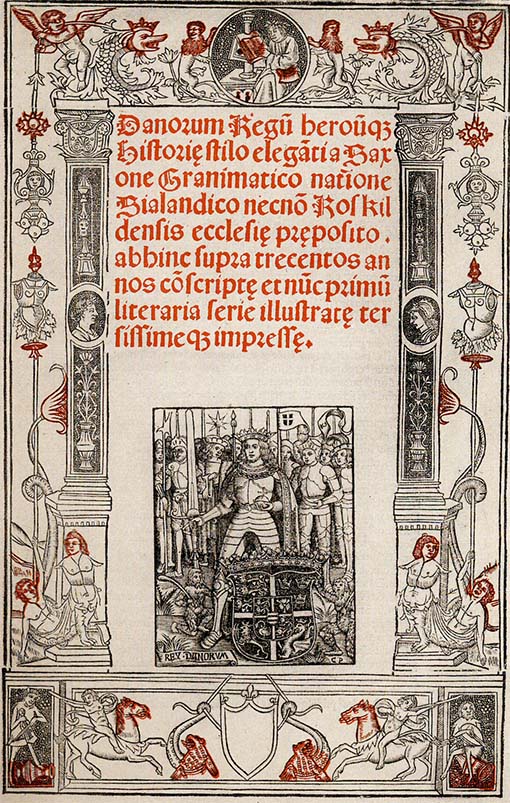
Rome of the North
Saxo’s classicizing Latin is a clear sign that he, in the words of scholar Franz Blatt, “is looking at Danish history through Roman eyes.” What is more, he divides Gesta Danorum into sixteen books, likely, as Lars Boje Mortensen has suggested, in imitation of Paul the Deacon’s Historia Romana, which during the Middle Ages was a much-read summary of Roman history. Incidentally, some manuscripts of this work give the misleading title Gesta Romanorum, but have nothing to do with the famous collection of legends with the same title. (It does, however, provide some clues as to where Saxo came up with the title Gesta Danorum; many other histories of peoples were commonly called gesta.)
Denmark’s Past Outshines That of Rome
That Denmark in some ways outdid ancient Rome is also implied by Saxo. First of all, Denmark is more ancient: while the Romans had their Augustus, the Danes were already on the third king named Frotho. Secondly, though the Romans might have held their poets in esteem, the Danes even awarded the kingship to Hjarni on account of a short poem. It is regrettable, writes Saxo, that the Danes did not have access to Latin to record their great deeds, but merely had to make do with their songs and runic letters:
“Quantum porro ingenii illius homines historiarum edituros putemus, si scribendi sitim Latinitatis peritia pavissent”
Gesta Danorum praefatio 1. 3
‘How many works of history do we suppose that such ingenious people would have produced, if they had slaked their thirst for writing with proficiency in the Latin language’
Accordingly, Saxo seeks to remedy this shortcoming by casting the songs and stories of the Danish past into a prestigious Latin form. In this way, scholars both Danish and foreign would be impressed by the exploits and adventures of the ancient Danes. Their deeds would finally have a worthy chronicler, who, to my mind, proved to be the greatest Latinist that the medieval North ever produced.
How Could a Dane Learn Latin So Well?
Just as Erasmus expressed his “wonder, where a Dane of this age could acquire such power of expression,” many later readers and lovers of Latin have been variously enthralled and intimidated by Saxo’s use of language. Where did he learn it?
Though we know little of his life, it has long been assumed that Saxo studied in France, like many of his compatriots. Giving a fascinating insight into the mobility of medieval scholars, Arnold of Lübeck in his Chronica Slavorum (early 13th century) makes the following comment on Danes traveling to France:
Scientia quoque litterali non parum profecerunt, quia nobiliores terrae filios suos non solum ad clerum promovendum, verum etiam saecularibus rebus instituendos Parisius mittunt. Ubi litteratura simul et idiomate lingua terrae illius imbuti, non solum in artibus, sed etiam in theologia multum invaluerunt.
Chronica Slavorum III. 5, ch. De honestate Danorum
‘Even in letters the Danes have made not insignificant progress; the noblemen of the country send their sons to Paris not only to be trained as clerics but also to be taught in the worldly sciences. There they become acquainted with the literature and language of this land, acquiring much skill not only in the arts but also in theology.’
Saxo’s poems, infused by Vergil and Horace, are metrically some of the most flawless of his time, which makes France the most likely destination for his studies in verse composition. In the 12th century this was where the best quantitative verse was written and taught.
The Latin of Paris, Orléans or Reims?
Most students went to Paris, but the study of classical literature also flourished in Orléans – making these two cities good contenders for Saxo’s years of study. A quote by Matthew of Vendôme comes to mind: “Parisius logicam sibi iactitet, Aurelianis / auctores, elegos Vindocinense solum” ‘Let Paris boast of logic, Orléans of the authors, Vendôme of its elegies.” (The auctores here denote the authors of classical antiquity.)
Reims is another possibility. The late Karsten Friis-Jensen, the foremost scholar of Saxo in our time, pointed out some noteworthy connections between a Carthusian abbey in Reims and two Danish archbishops active before and during Saxo’s presumed period in France. Furthermore, in the 1170s when Saxo would have been busy with his studies, Reims was the home of the most famous poet of the age, Walter of Châtillon, who composed the Alexandreis, a verse epic on the life of Alexander the Great. This, in fact, is the only contemporary Latin poem that Saxo borrows from.
Is the Latin of Saxo Difficult?
It is often said that the peculiarities treated above make Saxo one of the more difficult writers of the Middle Ages. I’ll let any Latinists reading this judge by themselves!
Arnold the Icelander
The following passage describes events in the years 1167–1168, when King Valdemar I of Denmark together with Bishop Absalon (later archbishop) were waging war on the Slavic Wends. It gives a fascinating depiction of a Norse skald, Arnold the Icelander, who seems to be identical with Arnaldr (or Arnhallr) Þorvaldsson, known in Old Icelandic texts. Such skalds were likely important sources for Saxo’s history:
Habebat autem in clientela Absalon Arnoldum Tylensem, qui sive ingenii acumine sive coniecturarum sagacitate saepenumero futura ad sua uel amicorum negotia pertinentia raro praesagio deprehendebat. Nec minus antiquitatis quam divinationis peritus sollerti historiarum narratione callebat. Qui cum Absaloni delectandi gratia supradictae expeditionis comes existeret, brevi eum manum cum piratis conserturum praedixerat, vehementer se mirari testatus, quo pacto certamini interfuturus non sit, praesertim cum inseparabiliter eum comitari decreverit. Cumque rege res gestas ex eo cognoscere cupiente discessuro Absalone quiescere rogaretur, pertinacissime precibus obluctatus non prius rogatui cessit, quam rex operam se daturum polliceretur, ut eum post Absalonem prima luce dimitteret.
Gesta Danorum XIV. 36. 2
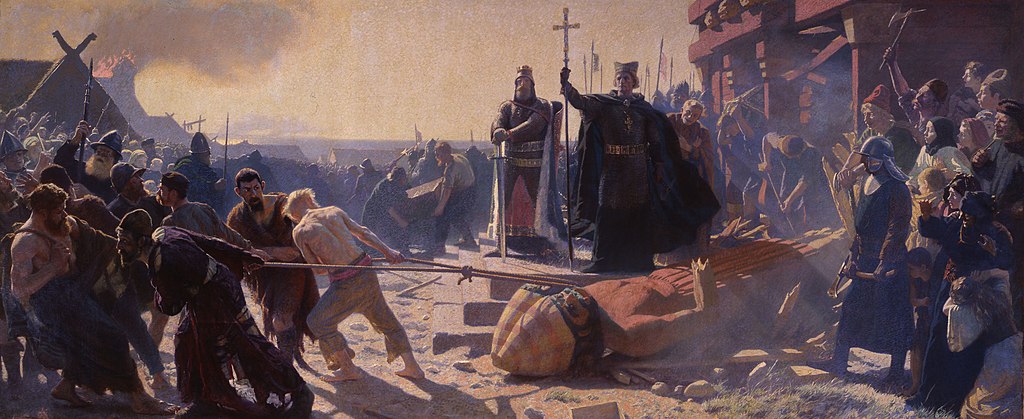
War Poetry, in Prose
War is of course an ever-present subject, often described, as in the following battle scene, with a poetic vigor that is far from Caesar’s dry reports (I’m allowed to say this because I’ve taught Caesar):
Deinde canentibus lituis summa utrimque vi conseritur bellum. Crederes repente terris ingruere caelum, silvas camposque subsidere, misceri omnia, antiquum rediisse chaos, divina pariter et humana tumultuosa tempestate confundi, cunctaque simul in perniciem trahi. Nam ubi ad teli iactum perventum, intolerabilis armorum stridor incredibili cuncta fragore complevit. Vapor vulnerum repentinam caelo nebulam intendebat, dies effusa telorum grandine tegebatur. Nec parum in acie funditorum opera valuit. At ubi pila manu aut tormentis excussa, comminus gladiis ferratisque clavis decernitur. Tum vero plurimum sanguinis periclitatum est. Igitur fessis manare sudor corporibus coepit, mucronumque crepitacula eminus exaudiebantur.
Gesta Danorum VIII. 4. 4
Bjarkamál in Latin
To end with a few lines of poetry, this is an excerpt from Saxo’s hexameter rendition of the Old Norse Bjarkamál. This poem is believed to have been composed around the year 1000 and depicts the fall of King Hrólfr Kraki at Lejre, who was betrayed by an army of Swedes and Geats. The speaker here is Hjalti, one of the king’s champions:
Ecce, furens equoque sui fidentior hostis
ferro artus faciemque aurata casside tectus
in medios fertur cuneos, ceu vincere certus
intimidusque fuge et nullo superabilis ausu.
Suetica, me miserum, Danos fiducia spernit.
Ecce, truces oculis Gothi visuque feroces
cristatis galeis hastisque sonantibus instant.
In nostro validam peragentes sanguine cladem
distringunt gladios et acutas cote bipennes.
Quid te, Hiartve loquar? Quem Sculda nocente replevit
consilio tantaque dedit crudescere culpa?
Quid te, infande, canam, nostri discriminis auctor,
proditor eximii regis, quem saeva libido
imperii tentare nefas furiisque citatum
coniugis aeternam pepulit pretendere noxam?
Quis te error factum Danis dominoque nocentem
praecipitavit in hoc caecum scelus? Unde subibat
impietas tanto fraudis constructa paratu?
Gesta Danorum II. 7. 8.
Literature
If you wish to read Gesta Danorum, the modern text edition is published by Oxford Medieval Texts and has a facing English translation: Friis-Jensen, Karsten (ed.) & Peter Fisher (transl.). 2015. Saxo Grammaticus, Gesta Danorum: The History of the Danes. Vol. I and Vol. II. Oxford: Oxford University Press. Friis-Jensen also wrote the standard work on Saxo’s poetry: Friis-Jensen, Karsten. 1987. Saxo Grammaticus as Latin Poet: Studies in the Verse Passages of the Gesta Danorum. Diss. (Analecta Romana Instituti Danici. Supplementa, 14.) Rome: Bretschneider.
An accessible introduction to Saxo by Friis-Jensen can be found in Medieval Nordic Literature in Latin: A Website of Authors and Anonymous Works c. 1100–1530.
The letters by Christiern Pedersen and Bishop Lage Urne are cited in the first printed edition: Saxo Grammaticus, Danorum regum heroumque historiae. Christiern Pedersen (ed.). 1514. Paris: Jodocus Badius Ascensius. See Archive.org, or, for a high-res version, the National Library of Sweden, which has also provided the background image for this article; the latter is the copy once owned by brothers Olaus and Johannes Magnus, which is expounded upon in another piece on Saxo by Latinitium’s own Amelie Rosengren.
For more on Jodocus Badius see White, Paul. 2013. Jodocus Badius Ascensius: Commentary, Commerce and Print in the Renaissance. Oxford: Oxford University Press. A history and catalogue of the editions of the Prelum Ascensianum can be found in Renouard, Philippe. 1908. Bibliographie des impressions et des oeuvres de Josse Badius Ascensius, imprimeur et humaniste 1462–1535. Paris. (See BnF Gallica: vol. I, vol. II, vol. III.).
Franz Blatt has written on the language of Saxo, partly in the preface to his dictionary to Gesta Danorum (in Danish and in Latin) and partly in a brief article (in Danish): Blatt, Franz (ed.). 1957. Saxo Grammaticus, Gesta Danorum. Tomus II: Index verborum. Copenhagen: Det Danske Sprog- og Litteraturselskab; and: Blatt, Franz. 1975. Saxo, En Repræsentant for det 12. Århundredes Renæssance. In: I. Boserup (ed.), Saxostudier. (Opuscula Graecolatina, 2.) Copenhagen: Museum Tusculanum, pp. 11–19.
Vedel’s words on the difficulty of Saxo’s Latin is to be found in the preface of his translation of Gesta Danorum: Vedel, Anders (transl.). 1575. Den danske krønicke som Saxo Grammaticus screff, halfffierde hundrede Aar forleden: Nu først aff Latinen udsæt, flittelige offuerseet oc forbedret. Copenhagen, B 4 r.
The suggestion that the division of Gesta Danorum into sixteen books was inspired by Paul the Deacon’s Historia Romana is found in: Mortensen, Lars Boje. 1987. Saxo Grammaticus’ View of the Origin of the Danes and his Historiographical Models. Cahiers de l’Institut du Moyen Âge Grec et Latin, vol. 55, pp. 169–183.
You can read Arnold of Lübeck’s description of Danish students going to Paris in Johannes M. Lappenberg & Georg Heinrich Pertz (ed.). 1868. Arnoldi Chronica Slavorum. Scriptores rerum Germanicarum in usum scholarum recusi, p. 77.
The quote by Matthew of Vendôme appears in the prologue to his letters in elegiac couplets, edited by Munari, Franco. 1982. Mathei Vindocinensis opera. Vol. II. Piramus et Tisbe; Milo; Epistule; Tobias. Roma: Edizioni di storia e letteratura, p. 76.















